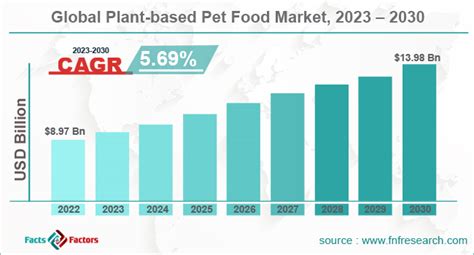Introduction

The global plant-based pet food market is experiencing significant growth. Fueled by increasing consumer demand for ethical, sustainable, and healthy pet food options, the market is projected to reach a value of over $10 billion by 2025.
Key Trends
1. Growing Consumer Demand
Consumers are increasingly turning to plant-based pet food due to:
- Concerns about animal welfare
- Environmental sustainability
- Health and well-being of their pets
2. Innovation and Product Development
Pet food manufacturers are investing heavily in developing innovative plant-based products to meet consumer demand. These products are designed to:
- Mimic the taste and texture of traditional animal-based pet food
- Provide complete and balanced nutrition
3. Expansion of Distribution Channels
Plant-based pet food is becoming more accessible through:
- Online retailers
- Pet specialty stores
- Major retail chains
4. The Rise of Superfoods
Plant-based pet foods are increasingly incorporating superfoods to boost nutritional value. These ingredients include:
- Fruits and vegetables
- Legumes
- Whole grains
5. Growing Awareness of Health Benefits
Research suggests that plant-based pet food may provide health benefits for pets, including:
- Reduced risk of obesity
- Improved skin and coat health
- Support for a healthy immune system
Market Comparison
Plant-Based Pet Food VS Traditional Pet Food
| Feature | Plant-Based | Traditional |
|---|---|---|
| Ingredients | Plant-based sources | Animal-based sources |
| Nutritional Value | Can be complete and balanced | Typically complete and balanced |
| Health Benefits | Potential benefits for weight management and immune health | Established health benefits |
| Environmental Impact | Lower environmental footprint | Higher environmental footprint |
| Cost | Slightly higher | Typically lower |
Pain Points and Motivations
Pain Points
- Limited availability of plant-based pet food options
- Higher cost than traditional pet food
Motivations
- Concerns about animal welfare
- Environmental sustainability
- Health and well-being of pets
Common Mistakes to Avoid
- Not researching the nutritional needs of pets before switching to a plant-based diet
- Assuming all plant-based pet foods are created equal
- Overfeeding pets to compensate for perceived lower calorie content
Pros and Cons
Pros
- Ethical and sustainable
- Potential health benefits
- Reduced environmental footprint
Cons
- Higher cost
- Limited availability
- Potential for nutrient deficiencies if not formulated correctly
FAQs
-
Is plant-based pet food safe for my pet?
Yes, plant-based pet food can be safe and nutritious for pets when formulated correctly.
-
Will my pet like the taste of plant-based pet food?
Many pets enjoy the taste of plant-based pet food. Manufacturers use flavorings and textures to make it appealing.
-
Can plant-based pet food provide complete and balanced nutrition?
Plant-based pet food can be formulated to provide complete and balanced nutrition for pets. Check the label to ensure it meets AAFCO standards.
-
How can I transition my pet to a plant-based diet?
Gradually introduce plant-based pet food into your pet’s diet over 7-10 days to minimize digestive upset.
Case Detail: Beyond Meat and Purina Launch Dog Food
In 2021, plant-based meat company Beyond Meat partnered with pet food giant Purina to launch a line of plant-based dog food called “Beyond Meat Jerky Treats.” This product demonstrates the growing collaboration between the plant-based food industry and the pet food industry to meet consumer demand for sustainable and ethical pet food options.
Conclusion
The plant-based pet food market is rapidly growing, driven by consumer demand for ethical, sustainable, and healthy pet food options. As innovation and product development continue to drive the market, plant-based pet food is expected to become an increasingly significant part of the global pet food industry.





















